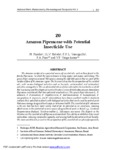Por favor, use este identificador para citar o enlazar este ítem:
http://www.alice.cnptia.embrapa.br/alice/handle/doc/979638| Título: | Amazon piperaceae with potential insecticide use. |
| Autor: | FAZOLIN, M.  ESTRELA, J. L. V.   YAMAGUCHI, K. K. L.   PIERI, F. A.   VEIGA-JUNIOR, V. F.   |
| Afiliación: | MURILO FAZOLIN, CPAF-AC. |
| Año: | 2014 |
| Referencia: | In: GUPTA, V. K. (ed.). Medicinal plants: phytochemistry, pharmacology and therapeutics. New Delhi: Daya Publishing House, 2014. |
| Páginas: | p. 423-439. |
| Descripción: | The Amazon rainf orest is a potential source of essential oils, such as thosef ound in the family Piperaceae, to which the species known as long pepper and pepper jack belong . The genus Piper comprises around 700 species, among the 140-300 species that are part of the rainf orestfl ora of the Amazon region. The literature describes the composition of its essential oils, with various biological activities such as larvicide, antimicrobial, and antioxidant activities, among others. The use of essential oils as af uture alternative to insecticides is af ield that is growing, and this chapter presents a literature review of studiesf ocusing on Amazonian Piperaceae essential oils that have potential insecticide use. The species Piper aduncum L., P. callosum, P. divaricatum, P. hispidinervum, P. hostimannianum, P. humaytanum, P. marginatum, P. nigrum L., and P. tuberculatum, have shown excellent results in studies to evaluate their potential as plants with biological activities that can be used to control pests that cause damage to agricultural crops, or to human health. The essential oil of P. aduncum is the one that has been most widely studied f or its potential as an insecticide, showingeff ectiveness in the control of various species of agricultural pests in Brazil e.g ., Cerotomatingomarianus Bechyné, Tenebrio molitor L., Solenopsis saevissima. The Reports in the literature on the essential oils of Piperaceae demonstrate their ability to inhibit or delay insect maturation, reducing reproductive capacity, and causing death by starvation or direct toxicity. The main constituents present in the composition of the essential oils are phenylpropanoids, farnesene, and a-bisabolol. The wide biological diversity, largely unexplored, especially in tropical regions like the Amazon rainf orest, holdsgreat potentialf or research into new products that could replace conventional insecticides, or be used as part of synergisticf ormulations in the eff orts to control insect resistance to these products. |
| Thesagro: | Inseticida Óleo Piperaceae |
| NAL Thesaurus: | Amazonia |
| Palabras clave: | Brasil |
| Tipo de Material: | Parte de livro |
| Acceso: | openAccess |
| Aparece en las colecciones: | Capítulo em livro científico (CPAF-AC)  |
Ficheros en este ítem:
| Fichero | Descripción | Tamaño | Formato | |
|---|---|---|---|---|
| 24900.pdf | 240,02 kB | Adobe PDF |  Visualizar/Abrir |









